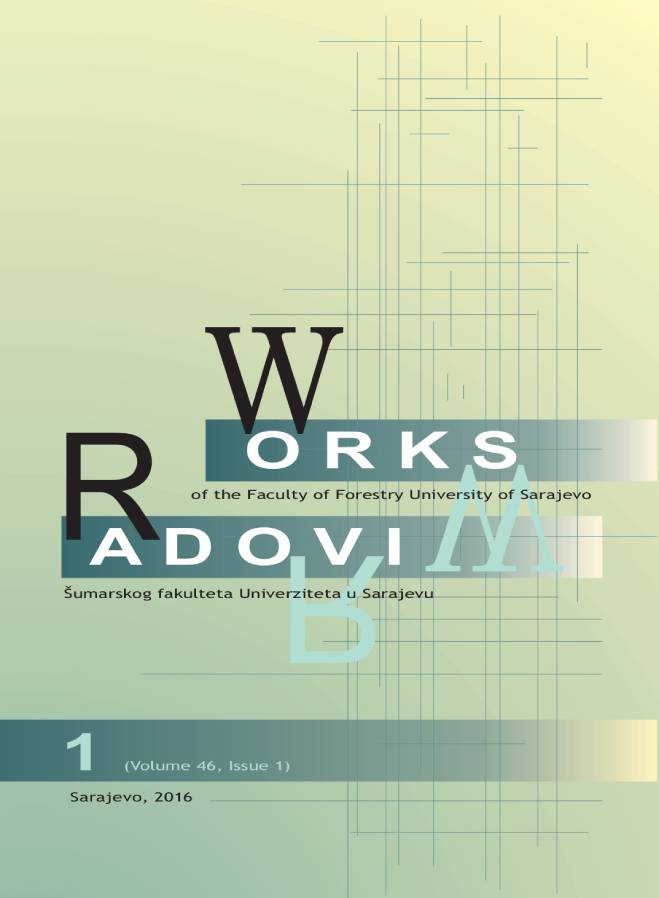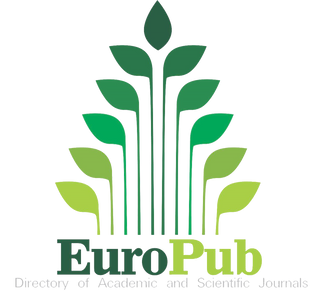Preliminarna fitohemijska analiza sekundarnih metabolita u listovima i kori 25 lišćarskih vrsta
DOI:
https://doi.org/10.54652/rsf.2016.v46.i1.79Ključne riječi:
anthocyanins, Bosnia and Herzegovina, coumarins, emodins, phenols, saponins, tanninsSažetak
UDK: 577.13:582
: Biljke proizvode brojne i raznolike sekundarne metabolite, organska jedinjenja koja nisu esencijalna i direktno ne sudjeluju u rastu i razviću, ali koja mogu imati vrlo važnu ulogu u adaptaciji i prilagodbi biljaka određenim okolišnim uvjetima. Za ljude su sekundarni metaboliti vrlo važni u medicini, farmakologiji te industriji hrane i kozmetike. Prisutnost osam vrsta sekundarnih metabolita (antocijanini, emodini, fenoli, kumarini, masne kiseline, saponini, steroidi i tanini) u vodenim ekstraktima listova i kore 25 lišćarskih drvenastih vrsta, u okviru 15 porodica, je kvalitativno istraživano brzim fitohemijskim metodama. Prema literaturnim podacima, u ovoj studiji je po prvi put utvrđeno prisustvo šest tipova sekundarnih metabolita u analiziranim drvenastim vrstama: antocijanini u jednoj vrsti; kumarini i fenoli u po pet vrsta; emodini u šest vrsta; saponini u osam vrsta; te tanini u četiri vrste. Posebnu pažnju u daljnjem istraživanju treba posvetiti Fagus sylvatica L., Populus tremula L., Quercus petraea (Matt.) Liebl., Robinia pseudoacacia L. i Sorbus aria (L.) Crantz. Budući da su preliminarni rezultati ovog istraživanja obećavajući, bilo bi poželjno identificirati aktivna jedinjenja i procijeniti njihovu potencijalnu antimikrobnu i antioksidativnu aktivnost.
Downloads
References
AHMET A. (2011): Development of quality profile of Salix caprea and its aromatic water. PhD Thesis, University of Kashmir Srinagar, Kashmir, Pakistan.
ALEXANDER J. (2009): Saponins in Madhuca longifolia L. as undesirable substances in animal feed. The EFSA Journal 979: 1-36.
AL-TAWEEL M. (2000): Phytochemical and biological studies of some Clematis species growing in Saudi Arabia. PhD Thesis, Department of Pharmacognosy at the College of Pharmacy King Saud University, Saudi Arabia.
ANDRÉ O, VOLLENWEIDER P, GÜNTHARDT-GOERG MS. (2006): Foliage response to heavy metal contamination in Sycamore Maple (Acer pseudoplatanus L.). For. Snow Landsc. Res. 80(3): 275-288.
AYERS AC, BARRETT RP, CHEEKE PR. (1996): Feeding value of tree leaves (hybrid popular and black locust) evaluated with sheep, goats, and rabbits. Animal Feed Science and Technology 57: 51-62.
AYOOLA GA, COKER HAB, ADESEGUN SA, ADEPOJU-BELLO AA, OBAWEYA K, EZENNIA EC, ATANGBAYILA TO. (2008): Phytochemical screening and antioxidant activities of some selected medicinal plants used for malaria therapy in South Western Nigeria. Trop J Pharm Res 7(3): 1019-1024.
BHANDARY SK, KUMARI NS, BHAT VS, SHARMILA KP, BEKAL MP. (2012): Preliminary phytochemical screening of various extracts of Punica granatum peel, whole fruit and seeds. Nitte Univ J Health Sci 2(4): 34-38.
BISHOP GJ, KONCZ C. (2002): Regulation of transcript levels of Arabidopsis chtochrome P450 grnrs involved in brassinosteroid biosynthesis. Plant Physiology 130: 504-513.
BRINDZA P, KLIMENKO SV, GRIGORIEVA O, BRINDZA J, TOTH D. (2009): Biological and commercial characteristics of Cornelian Cherry (Cornus mas L.) population in the Gemer region of Slovakia. International Symposium on Pomegranate and Minor Mediterranean Fruits, Vol. 818, Adana,Turkey: p. 85-93.
CALDER PC. (2015): Functional roles of fatty acids and their effects on human health. J Parenter Enteral Nutr. 39(1 Suppl): 18S-32S.
ČEKSTERYTĖ V. (2012): Composition and content of fatty acids in beebread of various floral origin, collected in Lithuania and prepared for storage in different ways. Cheminė technologija 2: 60.
CODREANU M-V, ISTUDOR V, DOCIU N. (2007): Acer tataricum L. seeds – a new convenient source of gamma-linolenic acid. , Acta Chromatographica 19: 238-245.
CONFORTI F, IOELE G, STATTI G, MARRELLI M, RAGNO G, MENICHINI M. (2008): Antiproliferative activity against human tumor cell lines and toxicity test on Mediterranean dietary plants. Food and chemical toxicology 46: 3325-3332.
DOUGHARI JH. (2012): Phytochemicals: extraction methods, basic structures and mode of action as potential chemotherapeutic agents. In: Rao V. (Ed), Phytochemicals – A global perspective of their role in nutrition and health, ISBN: 978-953-51-0296-0, InTech, DOI: 10.5772/26052.
EL-TAHAWI BS, DIAB MA, HABIB MA, ALY MA. (1983): Steroid composition of the Egyptian peach oir. Journal of Agricultural Research 6: 303-319.
FORESTRY COMMISSION (2001): Forestry Statistics 2001. A compendium of statistics about woodland, forestry and primary wood processing in the UK. Forestry Commission, Edinburgh.
GIBBS RD. (1974): Chemotaxonomy of flowering plants. Vol.1, McGill Queen’s University Press, Montreal and London.
GOTTLIEB OR. (1990): Phytochemicals: differentiation and function. Phytochemistry 29: 1715-1724.
GUETTAF S, ABIDLI N, KARICHE S, BELLEBCIR L, BOURICHE H. (2016): Phytochemical screening and antioxidant activity of aqueous extract of Genista saharae (Coss. & Dur.). Der Pharmacia Lettre 8 (1): 50-60.
GUZIK G. (2012): EPR study on sugar radicals utilized for detection of radiation treatment of food. Nukleonika 57: 545-549.
HAMILTON JG, ZANGERL AR, BERENBAUM MR, SPARKS JP, ELICH L, EISENSTEIN A, DELUCIA EH. (2004): Insect herbivory in an intact forest understory under experimental CO2 enrichment. Oecologia 138: 566-573.
HARINI K, JERLINSHOWMYA J, GEETHA N. (2014): Phytochemical constituents of different extracts from the leaves of Chromolaena odorata (L.) King and Robinson. International Journal of Pharmaceutical Sciences and Business Management 2(12): 13-20.
HEGAB MM, GHAREIB HR. (2010): Antioxidative effects of acetone fraction and vanillic acid from Chenopodium murale L. on tomato plant. Weed Biol Manag 10: 64-72.
HEINRICH M. (2005): Co-ordinator of the local food-nutraceuticals consortium. Understanding local Mediterranean diets: a multidisciplinary pharmacological and ethnobotanical approach. Pharmacological Research 52: 353-366.
IZHAKI I. (2002): Emodin – a secondary metabolite with multiple ecological functions in higher plants. New Phytologist 155(2): 205-217.
JEPPSSON N. (1995): The effect of cultivar and cracking on fruit quality in Black Chokeberry (Aronia melanocarpa) and hybrids between chokeberry and rowan (Sorbus). Gartenbauwissenschaft 65: 93-98.
KACHROO A, KACHROO P. (2009): Fatty acid-derived signals in plant defense. Annual Review of Phytopathology 47: 153-176.
KIM DO, HEO HJ, KIM YJ, YANG HS, LEE CZ. (2005): Sweet and sour cherry phenolics and their protective effects on neuronal cells. Journal of Agricultural and Food Chemistry 53: 9921-9927.
KOCHE D, SHIRSAT R, IMRAN S, BHADANGE DG. (2010): Phytochemical screening of eight traditionally used ethnomedicinal plants from akola district (MS) India. International Journal of Pharma and Bio Sciences 1(4): 253-256.
KOSTOVA I. (2001): Fraxinus ornus L. Fitoterapia 72(5): 471-480.
KOUL O. (2008): Phytochemicals and insect control: an antifeedant approach. Critical reviews in plant sciences 27: 1-24.
KUMAR A, ILAVARASN R, JAYACHANDRAN T, DECARAMAN M, ARAVINDHAN P, PADMANABAN N, KRISHNAN MRV. (2009): Phytochemical investigation on a tropical plant. Pak J Nutri 8: 83-85.
KYLLI P. (2011): Berry phenolics: isolation, analysis, identification, and antioxidant properties. PhD Thesis, University of Helsinki, Department of Food and Environmental Sciences Food Chemistry. Helsinki, Finland.
LANDI M, TATTINI M, GOULD KS. (2015): Multiple functional roles of anthocyanins in plant-environment interactions. Environmental and Experimental Botany 119: 4-17.
LATTANZIO V, LATTANZIO VMT, CARDINALI A. (2006): Role of phenolics in the resistance mechanisms of plants against fungal pathogens and insects. Phytochemistry: Advances in Research: 23-67.
LEVITT J. (1980): Chilling, freezing, and high temperature stresses. Responses of plants to environmental stresses, Vol. 1. Academic Press, London, England.
LINDEBERG G. (1971): Aromatic substances in leaves of Populus tremula as inhibitors of mycorrhizal fungi. Physiologia Plantarum 25: 122-129.
LUTSENKO Y, BYLKA W, MATŁAWSKA I, DARMOHRAY Y. (2006): Hedera helix as a medicinal plant. Herba Polonica 56(1): 83-96.
MALEŠ Ž, KREMER D, GAŠPAR RANDIĆ Z, RANDIĆ M, HAZLER PILEPIĆ K, BOJIĆ M. (2010): Quantitative analysis of glucofrangulins and phenolic compounds in croatian Rhamnus and Frangula species. Acta biologica Cracoviensia series botanica 52: 108-113.
MAMDOH M. (2010): Benzoic acid metabolism in Sorbus aucuparia cell suspension cultures. PhD Thesis, Fakultät für Lebenswissenschaften der Technischen Universität Carolo-Wilhelmina, Braunschweig, Germany.
MANOJLOVIC N, MAŠKOVIĆ P, VASILJEVIĆ P, JELIĆ R, JUSKOVIĆ M, SOVRLIĆ M, MANDIĆ L, RADOJKOVIĆ M. (2012): HPLC analysis, antimicrobial and antioxidant activities of Daphne cneorum L. Hemijska industrija 66: 709-716.
MARINOVA E, YANISHLEVA N, KOSTOVA I. (1994): Antioxidative activity of phenolic acidson triacylglycerols and fatty acid methyl esters from olive oil. Institute of Organic Chemistry with Center of Phytochemistry, Sofia, Bulgaria, 56(2), p. 139-145.
MARKHAM KR. (1989): Plant phenolics. In: Harborne JB. (ed.), Methods in plant biochemistry, Vol. 1, Academic Press, London, UK, p. 197-235.
MARKOVIĆ M, MATOVIĆ M, PAVLOVIĆ D, ZLATKOVIĆ B, MARKOVIĆ A, JOTIĆ B, STANKOV V. (2010): Resources of medicinal plants and herbs collector’s calendar of Pirot County (Serbia). Biologica Nyssana 1: 9-21.
MATOS MJ, SANTANA L, URIARTE E, ABREU OA, MOLINA E, YORDI EG. (2015): Coumarins – An Important Class of Phytochemicals. In: Rao AV, Rao LG (Eds), Phytochemicals - Isolation, Characterisation and Role in Human Health, InTech, http://dx.doi.org/10.5772/59982, p. 113-140.
MERT-TÜRK F. (2006): Saponins versus plant fungal pathogens. Journal of Cell and Molecular Biology 5: 13-17.
MÍKA V, KUBÁŇ V, KLEJDUS B, ODSTRČILOVÁ V, NERUŠIL P. (2005): Phenolic compounds as chemical markers of low taxonomic levels in the family Poaceae. PLANT SOIL ENVIRON. 51(11): 506-512.
MIRUNALINI S, KRISHNAVENI M. (2011): Coumarin: a plant derived polyphenol with wide biomedical applications. International journal of PharmTech Research 3: 1693-1696.
OLIVIER A, VOLLENWAIDER P, GUNTHARDT-GOERG M. (2006): Foliage response to heavy metal contamination in Sycamore Maple (Acer pseudoplatanus L.). Forest, snow and landscape research 80: 275-288.
OLSZEWSKA MA. (2012): In vitro antioxidant activity and total phenolic content of the inflorescences, leaves and fruits of Sorbus torminalis (L.) Crantz. Acta Poloniae Pharmaceutica 68: 945-953.
PALTA JP. (1992): Mechanisms for obtaining freezing stress resistance in herbaceous plants. In: Plant Breeding in the 1990s. Proceedings of a symposium held at North Carolina State University, p. 219-250.
PARIS R, MOYSE H. (1969): Precis de matiere medicinale. Paris: Masson.
PEARCE R. (2000): Decay development and its restriction in trees. Journal of arboriculture 26: 1.
PETRYNIAK J, JANUSZ M, MARKOWSKA E, LISOWSKA E. (1981): Purification of the Euonymus europaeus lectin by affinity chromatography on the desialized MN blood group glycoprotein, and lectin NH2-terminal analysis. Acta Biochimica Polonica 28: 267-273.
PFEIFFER B, ALT S, HEIN B, SCHULZ C, KOLLAR A. (2004): Investigations on alternative substances for control of apple scab - Results from Conidia germinating tests and experiments with plant extracts. Proceeding from 11th International Conference on Cultivation Technique and Phytopathological Problems in Organic Fruit-Growing. Fördergemeinschaft Ökologischer Obstbau, Weinsberg, Germany, 101-107.
PUKACKA S, CZUBAK A. (1998): The effect of desiccation on viability and membrane lipid composition of Acer pseudoplatanus seeds. Acta societatis botanicorum Poloniae 67: 249-252.
RIMPAPA Z, TOROMANOVIĆ J, TAHIROVIĆ I, ŠAPČANIN A, SOFIĆ E. (2007): Total content of phenols and anthocyanins in edible fruits from Bosnia. Bosnian journal of basic medical sciences 7: 117-120.
RIZK AM. (1982): Constituents of plants growing in Qatar. Fitoterapia 52: 35-42.
ROWE J, CONNER A. (1979): Extractives in eastern hardwoods - A review. General Technical Report FPL 18. Forest Products Laboratory, Forest Service, US Department of agriculture Madison, Wisconsin, USA, p. 72.
SAVITHRAMMA N, LINGA RAO M, SUHRULATHA D. (2011): Screening of medicinal plants for secondary metabolites. Middle-East J Sci Res 8(3): 579-584.
SEERAM NP. (2008): Berry fruits: compositional elements, biochemical activities, and the impact of their intake on human health, performance, and disease. J Agric Food Chem 56(3): 627-629.
STOILOVA A, WILKER M, STOYANOVA A, KRASTANOV A, STANCHEV V. (2007): Antioxidant activity of extract from elder flower (Sambucus nigra L.). Herba Polonica 53: 45-54.
STRÁNSKÝ K, VALTEROVÁ I, FIEDLER P. (2001): Nonsaponifiable lipid components of the pollen of elder (Sambucus nigra L.). Journal of Chromatography A 936: 173-181.
SUBHASHINI DEVI P, SATYANARAYANA B, TARAKESWARA NAIDU M. (2014): Phytochemical screening for secondary metabolites in Boswellia serrata Roxb. and Wrightia tinctoria (Roxb.) R.Br. Not Sci Biol 6(4): 474-477.
TIWARI R, RANA CS. (2015): Plant secondary metabolites: a review. International Journal of Engineering Research and General Science 3(5): 661-670.
TREARE GE, EVANS WC. (1985): Pharmacognosy. 17th edition, Bahive Tinal, London, p. 149.
VARADARAJAN P, RATHINASWAMY G, ASIRVATAHM D. (2008): Antimicrobial properties and phytochemical constituents of Rheo discolor. Ethnobotanical Leaflet 12: 841-845.
WINK M, WATERMAN PG. (1999): Chemotaxonomy in relation to molecular phylogeny of plants. Annual Plants Reviews 2: 300-341.
WINK M. (1990): Physiology of secondary product formation in plants. In: Charlwood BV, Rhodes MJC (Eds), Secondary products from plant tissue culture, Clarendon Press, Oxford, p. 23-41.
WINK M. (1999): Biochemistry of plant secondary metabolism. Annual Plant Reviews 2, Sheffield Academic Press, London, UK.
WU X, CAO G, PRIOR RL. (2002): Absorption and metabolism of anthocyanins in elderly women after consumption of elderberry or blueberry. Journal of Nutrition 132: 1865-1871.
YANG L, WANG S, ZHAO Y, LIU K, WANG X, YANG Y. (2009): Chemical constituents from Clematis delavayi var. spinescens. Molecules 14: 4433-4439.
ZOOBI J, MOHD A. (2010): Two new phenolic compounds from the flowers of Salix caprea. International Research Journal of Pharmacy 2: 138-141.
ŽEPIČ V, ERIKA Š, KOROŠEC R, HANČIČ A, PRIMOŽ O, POLJANŠEK I. (2013): Influence of drying conditions on thermal and morphological behavior of microfibrilated and nanofibrilated cellulose. COST Action FP 0901 “Analytical techniques for biorefineries” –Tulln, Austria, p. 8-9.






















